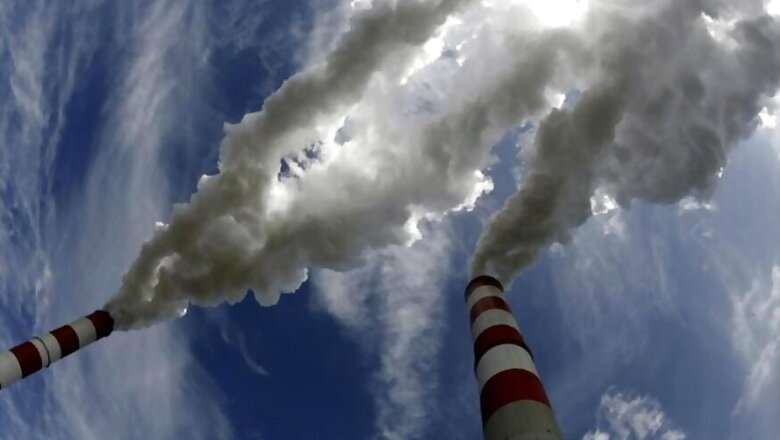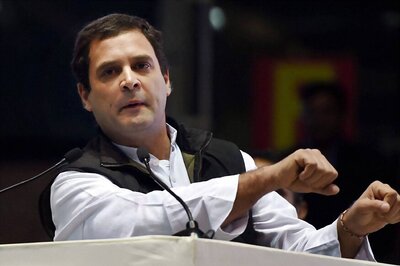
views
Washington: With the international community aggressively pushing for a carbon tax in a decisive fight against climate change, the IMF on Thursday said that the advanced economies may have greater responsibilities for mitigation, citing an example of India whose projected baseline emissions in 2030 per capita basis are only one-seventh of those for the US.
In its report 'Fiscal Monitor: How to Mitigate Climate Change', the International Monetary Fund (IMF) said that to limit global warming to 2C or less - the level deemed safe by science - large emitting countries need to take ambitious action. For example, they should introduce a carbon tax that could rise quickly to USD 75 a tonne in 2030, it argued.
Noting that the current mitigation pledges are not expressed using a common measure for all countries, thus hindering international comparisons, it said most future low-cost mitigation opportunities are in large, rapidly growing emerging market economies, especially those that rely heavily on coal.
"For example, with a globally uniform USD 25 a tonne carbon price in 2030, China and India would account for an estimated 56 and 15 per cent, respectively, of CO2 reductions (compared with baseline levels) from G20 countries, the US for 12 per cent, and all other G20 countries combined for 18 per cent," it said.
"However, advanced economies may have greater responsibilities for mitigation. Indeed, on a per capita basis, projected baseline emissions in India in 2030 are only one-seventh of those for the US," said the report released ahead of the annual meeting of the IMF and World Bank here.
Before considering the use of revenues from carbon pricing, carbon taxes would undoubtedly add to the cost of living for all households, and the burden as a share of total household consumption would range from moderately regressive to moderately progressive in selected countries, the IMF acknowledged.
"If no accompanying measures were taken, carbon taxes would be moderately regressive in China and the US, distribution-neutral in Canada, and moderately progressive in India for a USD 50 a tonne carbon tax in 2030. The reason is that in China and the US, the poor spend a greater share of their budget for electricity, but the opposite applies in India, the report said.
In India, the burden of carbon pricing would be somewhat larger for urban households than for rural households because of lower availability of, and less spending on, electricity in rural areas, the report noted.
Carbon taxes have uneven impacts across countries and economic sectors, the IMF said, adding that the average impact on industry costs of a USD 50 a tonne tax in 2030 ranges between 0.9 per cent in Canada and 5.3 per cent in China.
However, the most energy-intensive industries can be affected significantly: cost increases for the 20 per cent most vulnerable industries are 10.3 percent in China and 6.8 per cent in India, it said.
According to the IMF, carbon mitigation might also have large impacts on certain groups of workers and regions. Coal-related employment is projected to decline in many countries under baseline policies. A USD 50 a tonne carbon tax in 2030 would substantially accelerate this process; for example, increasing estimated job losses in this sector relative to 2015 levels from 8 to 55 per cent in the US and up to 42-45 per cent in China and India.
These job losses would amount to 0.30.9 per cent of economywide employment in China and Poland and less than 0.15 per cent in other countries; employment would increase in other sectors, such as renewables, but - in the absence of specific policies - the new jobs would likely become available in other regions, it said.
A model estimates suggest that reducing emissions to a level consistent with a 2C temperature target would require increasing the projected global energy investment in 2030 (encompassing both public and private) from 2.0 per cent of GDP to 2.3 per cent of GDP, with most of the increase concentrated in China and India.
The IMF report said that a uniform carbon prices of USD 25, USD 50, and USD 75 a tonne reduce CO2 emissions by 19, 29, and 35 per cent respectively, for the G20 group.
Whereas a USD 25 a tonne price would be more than enough for some countries (for example, China, India, and Russia) to meet their Paris Agreement pledges, in other cases (for example, Australia and Canada) even the USD 75 a tonne carbon tax falls short.
This dispersion reflects cross-country differences in the stringency of mitigation pledges, as well as in the price responsiveness of emissionsfor example, emissions are more responsive to pricing in coal- reliant countries such as China, India, and South Africa than in other countries, the report said.


















Comments
0 comment